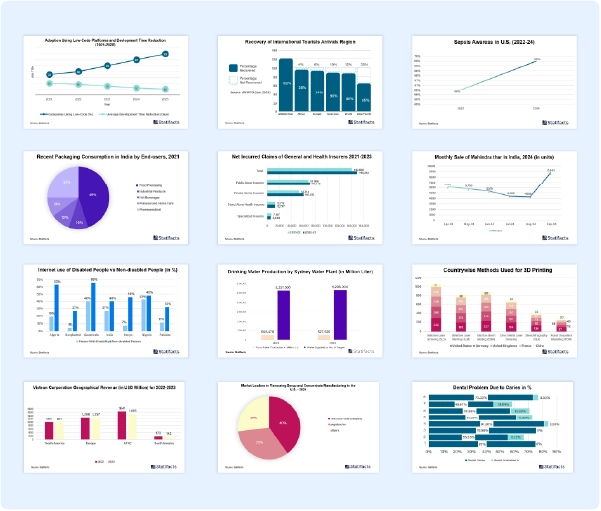The U.S. CRISPR and Cas genes market size is calculated at USD 1,010 million in 2024 and is predicted to reach around USD 5,110 million by 2034, expanding at a CAGR of 17.6% from 2025 to 2034.
U.S. CRISPR & Cas Genes Market Report Highlights
- By product & service, the product segment held the highest revenue share in 2024.
- By product & service, the service segment is projected to expand rapidly in the market in the coming years.
- By application, the biomedical segment registered the maximum market share in 2024.
- By application, the agricultural segment is predicted to witness significant growth in the market over the forecast period.
- By end-user, the biotechnology and pharmaceutical segment had the largest market share in 2024.
- By end-user, the academic and government research institutes' end-use segment is anticipated to grow at the fastest CAGR during the forecast period.
The U.S. CRISPR & Cas genes market refers to the production, distribution, and application of CRISPR & Cas genes in which CRISPR (clustered regularly interspaced short palindromic repeats) is a DNA sequence family found in the genomes of prokaryotic species like archaea and bacteria. At the time of the successive infections, they are employed to recognize and destroy DNA from related bacteriophages. In the genome engineering field, the term CRISPR or CRISPR-Cas9 may be used loosely to refer to the many CRISPR-Cas9 and -CPF1 and the other systems that can be programmed to target specific stretches of genetic code and to edit DNA at accurate locations as well as other purposes like for new diagnostic tools.
CRISPR and their associated proteins (Cas) display a prokaryotic adaptive immune system that memorizes previous infections by integrating short sequences of invading genomes termed spacers into the CRISPR locus. CRISPR-Cas9 is a revolutionary gene-editing technology that can be used to modify or correct accurate regions of our DNA to treat serious diseases. CRISPR is found in nearly 50% of sequenced bacterial genomes and nearly 90% of sequenced archaea. Cas or CRISPR-associated protein 9 is an enzyme that uses CRISPR sequences as a guide to recognize and open up specific strands of DNA that are complementary to the CRISPR sequence. The CRISPR-Cas tools are being highly used to correct genetic variants with the hope of treating several human genetic diseases like inherited blood disorders, including hemophilia, β-thalassemia, sickle cell disease, inherited eye diseases, and others.
The rising incidence of cancer is driving the growth of the U.S. CRISPR & Cas genes market. Researchers have used CRISPR-based gene editing to increase the expression of the PD-1 protein on T-cells, which helps to enhance their ability to target and kill cancer cells. CRISPR-Cas improves the immune response by allowing precise gene editing. The benefits of this gene therapy for cancer patients include preventing the production of a diseased protein, adding new genes to a cell to change the characteristics of the damaged genes, destroying malignant or cancerous cells, and inhibiting the excessive growth of benign or non-cancerous cells. This therapy can treat cancer by removing genes or correcting mutations. Many preliminary tumor treatment studies have been conducted in related fields. Cancer occupies the first ranking in human life-threatening, while mortality and mortality remain high. This technology is used to cure cancerous tumors caused by genetic variants.
Rising demand for gene editing contributes to the growth of the U.S. CRISPR & Cas genes market. Gene editing has its benefits. It holds the potential to cure genetic diseases and create crops resistant to drought. However, scientists need to work closely with law and policymakers to ensure the technology can be used for the benefit of mankind while minimizing the risks. Genetic therapies may be used to prevent, treat, or cure specific inherited disorders like sickle cell disease, beta thalassemia, hemophilia, alpha-1 antitrypsin deficiency, and cystic fibrosis. They also may be used to treat infections or cancers, including HIV. Gene editing benefits also include a new cancer treatment, helping crops tackle the climate crisis, and enhancing animal health. It can used to prevent simple genetic diseases and eventually eliminate the incidents of polygenic diseases.
The growing need for new therapeutics is driving the growth of the U.S. CRISPR & Cas genes market. Digital therapeutics have proven to be highly successful in the treatment of many types of central nervous system (CNS) conditions, offering advanced and effective interventions to enhance cognitive and motor function. Additional therapeutic benefits include reduction of symptoms, enhanced emotional and physical condition, and an enhanced prognosis for extended life expectancy. Access to new drugs or treatments that successfully enhance health is also an expected individual benefit.
Published by
Laxmi Narayan

